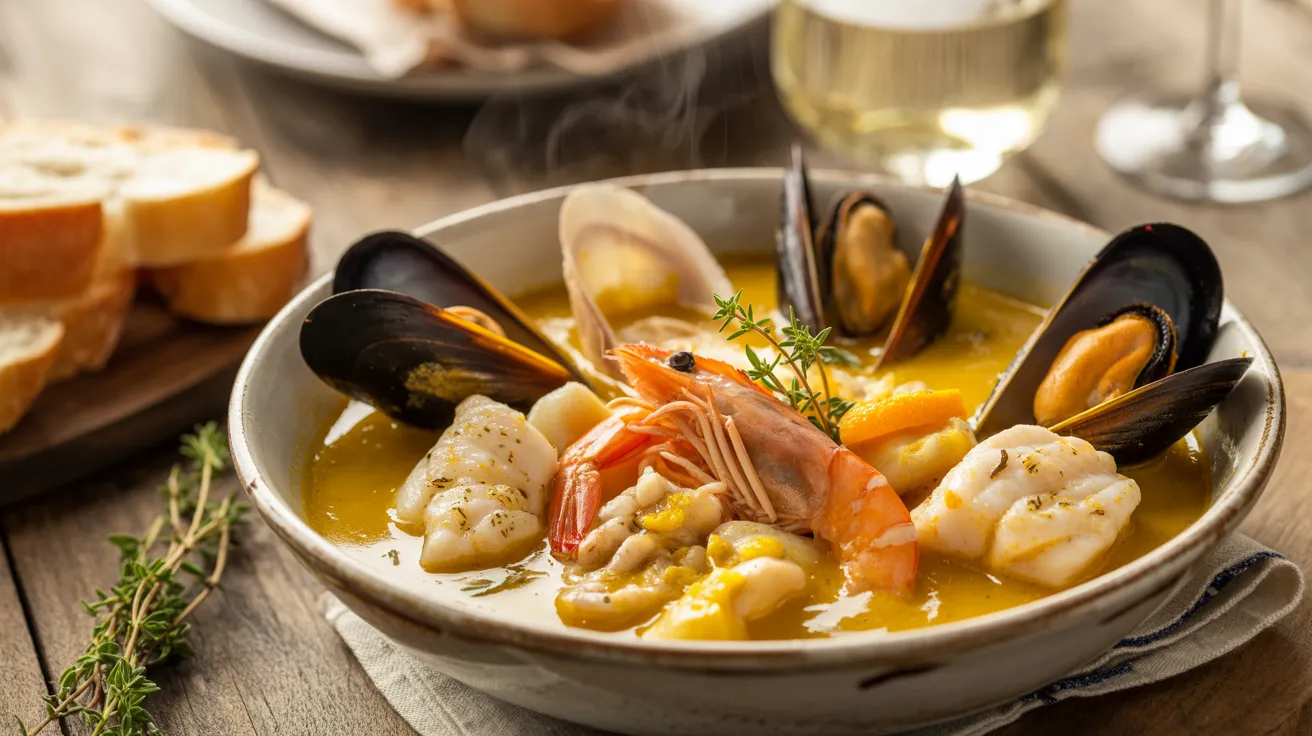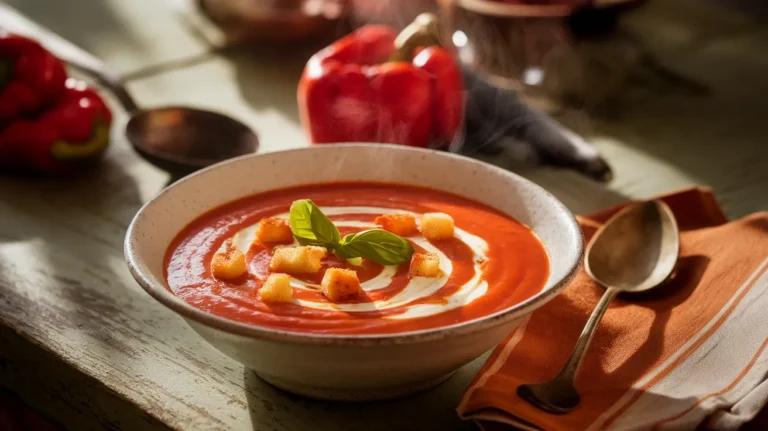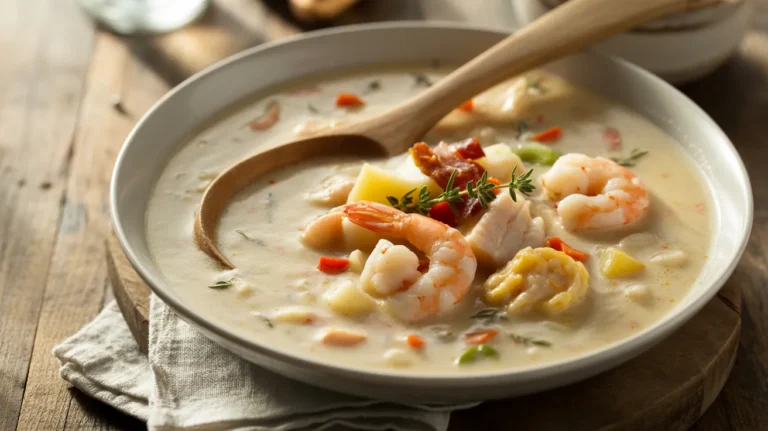This authentic bouillabaisse seafood stew brings the flavors of Marseille straight to your kitchen with foolproof instructions perfect for first-time cooks. Our beginner-friendly version of this classic French fish stew combines fresh seafood with aromatic herbs and golden saffron for a restaurant-quality meal that serves four. This bouillabaisse seafood stew recipe breaks down every technique into detailed steps, ensuring your first attempt will be absolutely delicious.
Recipe Info
SERVES: 4 | PREP: 20 MIN | COOK: 25 MIN | TOTAL: 45 MIN
Ingredients for Your Bouillabaisse Seafood Stew
Seafood Selection
| Ingredient | Amount |
|---|---|
| White fish fillets (halibut or cod) | 1 lb, cut into 2-inch pieces |
| Large shrimp | 12 pieces, peeled and deveined |
| Mussels | 1 lb, cleaned and debearded |
| Sea scallops | 8 large pieces |
Broth Base
| Ingredient | Amount |
|---|---|
| Fish stock or seafood broth | 4 cups |
| Dry white wine | 1/2 cup |
| Crushed tomatoes | 1 can (14 oz) |
| Saffron threads | 1/4 teaspoon |
| Bay leaves | 2 pieces |
Aromatics & Vegetables
| Ingredient | Amount |
|---|---|
| Yellow onion | 1 large, diced |
| Fennel bulb | 1 medium, sliced thin |
| Garlic cloves | 4 pieces, minced |
| Fresh thyme | 2 tablespoons |
| Orange zest | 1 tablespoon |
| Olive oil | 3 tablespoons |
| Salt and pepper | To taste |
Detailed Step-by-Step Instructions for Perfect Bouillabaisse Seafood Stew
Phase 1: Essential Prep Work (5 minutes)
Step 1: Prepare Your Saffron (2 minutes) Take your saffron threads and gently crush them between your thumb and forefinger. You’ll notice they break into smaller pieces and release a strong, earthy aroma. Place these crushed threads in a small bowl and add 2 tablespoons of warm fish stock. Stir gently and set aside. This soaking process is crucial – it releases the golden color and intense flavor that makes bouillabaisse seafood stew so special. The liquid should turn a beautiful golden-yellow color within minutes.
Step 2: Prepare All Seafood Properly (3 minutes) Remove all seafood from the refrigerator and let it sit at room temperature for 10 minutes while you prep other ingredients. Using paper towels, pat each piece of fish, shrimp, and scallops completely dry. Moisture on seafood will cause dangerous oil splattering and prevent proper browning. Check your mussels individually – tap any open shells with your finger. Live mussels will close when disturbed; discard any that remain open as they’re dead and unsafe to eat.
Phase 2: Mise en Place Setup (5 minutes)
Step 3: Organize Your Workspace Arrange all your prepared ingredients on your counter within easy reach of your stove. Place seafood on one side, chopped vegetables in the middle, and liquids on the other side. This French cooking technique called “mise en place” prevents scrambling for ingredients once cooking begins. Your bouillabaisse seafood stew will cook quickly, so organization is key to success.
Step 4: Prepare Your Cooking Vessel Use a large, heavy-bottomed Dutch oven or deep sauté pan – at least 6 quarts capacity. The heavy bottom prevents hot spots that could burn your aromatics. Place it on your stovetop over medium heat. Never use high heat for this recipe, as it will cause ingredients to brown too quickly and become bitter.
Phase 3: Building the Aromatic Base (8 minutes)
Step 5: Heat Oil to Perfect Temperature (1 minute) Add 3 tablespoons olive oil to your heated pot. Watch the oil carefully – it should shimmer and move freely when you tilt the pan, but never smoke. If it starts smoking, remove from heat for 30 seconds to cool down. The oil is ready when you can hold your hand 6 inches above the surface and feel gentle warmth.
Step 6: Sauté Onions and Fennel (4 minutes) Add your diced onion and sliced fennel to the hot oil. You should hear a gentle sizzling sound – if it’s violent splattering, your heat is too high. Stir every 30 seconds using a wooden spoon. The vegetables should soften and become translucent but never brown. If they start browning, reduce heat immediately. The fennel adds a subtle licorice note that’s essential to authentic bouillabaisse seafood stew.
Step 7: Add Garlic and Fresh Herbs (30 seconds) Push the softened vegetables to one side of the pot and add minced garlic, fresh thyme, and orange zest to the cleared space. This prevents the garlic from burning by giving it direct contact with oil. Stir constantly for exactly 30 seconds until fragrant. Garlic burns quickly and becomes bitter, so watch it carefully. The mixture should smell incredible at this point.
Step 8: Combine Everything (2 minutes) Stir all the aromatics together and cook for another 2 minutes, stirring frequently. The vegetables should be completely soft and the kitchen should smell like a French bistro. If anything starts sticking to the bottom, add a tablespoon of wine early to deglaze.
Phase 4: Creating the Bouillabaisse Broth (10 minutes)
Step 9: Deglaze with White Wine (2 minutes) Pour in the 1/2 cup white wine slowly – it will bubble vigorously at first. Use your wooden spoon to scrape up any browned bits stuck to the bottom of the pot. These bits are pure flavor and essential for authentic taste. Let the wine simmer actively for 2 full minutes to cook off the alcohol. You’ll know it’s ready when the sharp alcohol smell disappears.
Step 10: Add Tomatoes and Stock (3 minutes) Add the crushed tomatoes first, stirring to combine with the wine mixture. Then slowly pour in the fish stock – if you add it too quickly, it might splash and burn you. Add the bay leaves and your prepared saffron mixture (including the soaking liquid). The broth should immediately turn a gorgeous golden color from the saffron.
Step 11: Season and Bring to Simmer (5 minutes) Add 1 teaspoon salt and 1/2 teaspoon black pepper to start. Increase heat to medium-high and bring the mixture to a gentle boil. You’ll see bubbles forming around the edges first, then throughout the surface. Once it reaches a full boil, immediately reduce heat to medium-low to maintain a gentle simmer. The surface should have small, lazy bubbles – not violent bubbling that will make your broth cloudy.
Phase 5: Cooking Seafood for Perfect Bouillabaisse Seafood Stew (12 minutes)
Step 12: Add Firm White Fish First (3 minutes) Gently place your white fish pieces into the simmering broth using a slotted spoon. Don’t drop them in – lower them carefully to avoid splashing hot liquid. The fish should be mostly submerged but don’t worry if some pieces stick up slightly. Don’t stir at all – stirring will break the delicate fish into small pieces. Let them cook undisturbed for exactly 3 minutes.
Step 13: Add Mussels Strategically (immediately after Step 12) Place cleaned mussels into the broth hinge-side down. This position allows them to open properly as they cook. Nestle them between the fish pieces but don’t force them down. As they cook, they’ll release their briny juices into the bouillabaisse seafood stew, adding incredible depth of flavor. You should see them starting to open within 2 minutes.
Step 14: Time the Quick-Cooking Seafood (3 minutes after adding mussels) Now add your scallops and shrimp to the pot. Place scallops flat-side down for even cooking. Arrange shrimp in a single layer if possible. These items cook very quickly – scallops need 2-3 minutes per side, and shrimp cook in 2-4 minutes total. Set a timer for 4 minutes from this point.
Step 15: Watch for Doneness Cues (4 minutes) Watch carefully for these signs: fish should flake easily when gently prodded with a fork, shrimp should be bright pink and slightly curled, scallops should be opaque with a slight golden crust, and mussels should be wide open. If any mussels remain closed after 8 minutes of cooking, discard them immediately as they were dead before cooking.
Step 16: Final Seasoning Check (1 minute) Remove the bay leaves with tongs – they’ve done their job and shouldn’t be eaten. Taste the broth carefully (it’s hot!) and adjust seasoning. Add more salt if needed, a pinch of pepper for warmth, or a squeeze of fresh lemon juice to brighten all the flavors. The broth should taste rich, complex, and perfectly balanced.
Step 17: Rest and Serve (2 minutes) Remove the pot from heat and let it rest for 2-3 minutes. This brief resting period allows the flavors to settle and prevents tongue-burning temperatures. The seafood will continue cooking gently in the hot broth, so don’t worry about it cooling too much.
Professional Chef’s Notes for Bouillabaisse Success
Saffron Investment: Real saffron threads are expensive but irreplaceable in authentic bouillabaisse seafood stew. A little goes a long way, and the complex flavor and golden color can’t be replicated with substitutes.
Seafood Timing Mastery: The secret to restaurant-quality bouillabaisse is adding seafood in stages based on cooking time. This prevents some pieces from becoming overcooked while others remain raw – a common beginner mistake.
Stock Quality Matters: Use the highest quality fish or seafood stock you can find. If unavailable, mix half chicken stock with half clam juice for depth without overwhelming fishiness.
Temperature Control: Keep the broth at a gentle simmer throughout cooking. Aggressive bubbling will break apart delicate fish pieces and make your bouillabaisse seafood stew broth cloudy instead of clear and golden.
Nutrition Information (Per Serving)
- Calories: 285
- Protein: 32g
- Carbohydrates: 12g
- Fat: 11g
- Fiber: 3g
- Sodium: 890mg
Creative Bouillabaisse Seafood Stew Variations
Spicy Mediterranean Style: Add 1/4 teaspoon cayenne pepper and red pepper flakes for heat that complements the saffron beautifully without overwhelming the delicate seafood flavors.
Luxury Lobster Version: Replace scallops with lobster tail pieces for special occasions. The sweet lobster meat pairs perfectly with the aromatic broth. Check out our rich seafood chowder for more luxury seafood preparation techniques.
Provençal Garden Style: Include diced bell peppers and substitute fresh basil for thyme. This variation adds color and pairs wonderfully with techniques from our coconut lime fish soup recipe.
Budget-Friendly Family Version: Use more white fish and fewer expensive shellfish. Add extra fennel and tomatoes to maintain the authentic flavor profile without the high cost of premium seafood.
Storage & Reheating Your Bouillabaisse Seafood Stew
Refrigerator Storage: Store leftover bouillabaisse seafood stew in airtight containers in the refrigerator for up to 2 days. The flavors actually improve overnight as they meld together, though the seafood texture will soften slightly.
Proper Reheating Method: Warm gently over low heat, stirring very carefully to avoid breaking the fish. Add a splash of fish stock if the stew has thickened too much during storage.
Freezing Considerations: While technically possible, freezing isn’t recommended for this bouillabaisse seafood stew as seafood texture changes significantly. Fish becomes mushy and shrimp turn rubbery after thawing.
Make-Ahead Strategy: Prepare the aromatic broth base through step 11 up to one day ahead. Refrigerate and add fresh seafood when ready to serve for optimal results.

Troubleshooting Common Bouillabaisse Problems
Problem: Cloudy or Murky Broth Solution: You boiled too vigorously. Always keep heat at gentle simmer and skim any foam that rises to the surface during cooking. Strain through fine mesh if needed.
Problem: Overcooked, Rubbery Seafood Solution: Seafood continues cooking in hot broth even off heat. Remove from stove immediately when fish flakes and shrimp turn pink. Don’t leave on warm stovetop.
Problem: Bland or Flat Flavor Solution: Add more saffron, salt, or a splash of white wine. Fresh lemon juice brightens all flavors beautifully and adds the acidic balance this bouillabaisse seafood stew needs.
Problem: Overly Salty Broth Solution: Add diced potatoes and simmer 10 minutes, then remove them. They’ll absorb excess salt without changing the stew’s character or consistency.
Problem: Mussels Won’t Open During Cooking Solution: Dead mussels before cooking won’t open no matter how long you cook them. Always tap shells before cooking – live ones close when disturbed. Discard any that remain closed after 8 minutes of cooking.
Essential Equipment for Perfect Results
- Large Dutch oven (6-quart minimum capacity)
- Sharp chef’s knife for precise prep work
- Cutting board with groove to catch juices
- Wooden spoon for gentle stirring without scratching
- Ladle for elegant serving
- Fine-mesh strainer for skimming foam
- Small bowls for saffron soaking and mise en place
- Timer for precise seafood cooking
Complete Shopping List for Bouillabaisse Seafood Stew
Seafood Counter
- White fish fillets (1 lb) – halibut or cod
- Large shrimp (12 pieces) – 16/20 count
- Fresh mussels (1 lb) – cleaned and debearded
- Sea scallops (8 large) – U-10 or U-12 size
Produce Section
- Yellow onion (1 large)
- Fennel bulb (1 medium)
- Fresh garlic (1 head)
- Fresh thyme (1 package)
- Orange (1 for zest)
- Lemon (1 for potential seasoning)
Pantry & Specialty Items
- Saffron threads (1 small container)
- Fish stock (32 oz container)
- Dry white wine (1 bottle)
- Crushed tomatoes (14 oz can)
- Bay leaves (dried)
- Extra virgin olive oil
Five Success Secrets for Perfect Bouillabaisse
- Buy the freshest seafood possible – Visit your fishmonger the day you plan to cook. Fresh seafood makes all the difference in this simple preparation where delicate flavors shine.
- Never skip the saffron soaking step – This small detail releases maximum color and flavor from expensive saffron threads, creating the signature golden hue of authentic bouillabaisce seafood stew.
- Keep all seafood pieces uniform in size – Equal-sized pieces cook at the same rate, preventing some from overcooking while others remain raw. Cut fish into 2-inch pieces for best results.
- Taste and adjust the broth before adding seafood – Once seafood goes into the pot, you can’t simmer longer to develop flavors without ruining the delicate texture of fish and shellfish.
- Serve immediately after cooking – This bouillabaisse seafood stew is best enjoyed hot and fresh, when the seafood is at peak tenderness and the aromatic broth is steaming and fragrant.
This comprehensive bouillabaisse seafood stew recipe transforms an intimidating French classic into an achievable home-cooking triumph. With detailed instructions perfect for beginners, you’ll create a restaurant-worthy meal that showcases the pure, clean flavors of fresh seafood enhanced by aromatic herbs and golden saffron. The combination of careful technique and quality ingredients ensures your first attempt at this traditional bouillabaisse seafood stew will be absolutely delicious.




